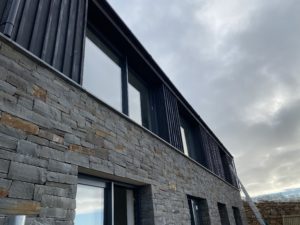Sustainable timber is increasingly being used in a range of construction products and applications across the world. In previous years, materials such as brick and concrete were popular choices, whilst timber cladding was more common in areas of Europe and Asia.
Nowadays, timber is being recognised for its highly versatile and sustainable properties, with everyone from architects to developers and builders selecting sustainable timber for their projects.
One increasingly popular way in which timber is being used in construction is for charred timber cladding. This practical design feature originates from Japan and is now growing in popularity across different areas of the world.
What is charred timber?
Yakisugi, (sometimes referred to as Shou Sugi Ban), is the Japanese art of charring timber. The process involves using a torch or open flame to create aesthetically pleasing effects on timber. Not only can this measure create stunning visual features, but it also has practical benefits as it helps with wood preservation.
By carefully burning the surface of the wood, the durability of the timber is increased.
How is charred cladding created?
The process of charring timber involves charring the wood evenly on the front face, sides and ends.
Once the wood has cooled, it is typically finished with a natural oil to seal it and protect it from water, dirt and changes in humidity.
It is not uncommon for the timber to incur slight surface burn variations; this tends to add to the wood’s unique nature.
Charring the outer surface of the wood helps to bring out its richness and grain structure. Meanwhile modifying the burning intensity creates different finishes, such as a traditional highly-charred look to a more modern, sleek, brushed effect.
What does charred timber cladding look like?
Charred wood cladding is often described as dark, dramatic and contemporary in appearance. It has a unique, warm and homogeneous look to it, and the texture and grain of the timber is brought out by hues of purple, blue and silver which appear against the charcoal black.

What are the benefits of charring wood?
As well as the general benefits of cladding, such as enhanced thermal efficiency and better aesthetics, there are plenty of advantages of charred timber cladding specifically. These include:
- Improved weather resistance
Timber is hygroscopic, which means that it is able to expand and contract in relation to moisture levels. As a result of this, the wood can crack, warp and rot during certain seasons of the year. When timber is charred, the burning removes the natural resins out of the wood and this leaves a layer of carbon on the surface. This provides the timber with a long-lasting weatherproof quality.
- Better fire resistance
Ironically, charred wood cladding has a higher resistance to fire. This is due to the fact that the charring process draws out the soft outer cells within the timber which ignite quickly. Instead, the strong lignin cells are revealed and these ignite at a much higher temperature.
- Visual enhancement
As aforementioned, charred timber cladding has a distinct, dark and warm appearance which can add a layer of significance to applications. Although it is becoming increasingly popular, charred wood cladding certainly still stands out as a highly appealing design feature. Some charred internal and external cladding projects also have unique features in the graining which again offers an aesthetically pleasing touch to projects.
- Insect repellant
The carbon outer layer featured on charred timber cladding acts as an effective insect deterrent, helping to prevent damage caused by termites, beetles and other types of insects.
Additionally, charred timber has increased resistance to mould and fungi. These organisms require a specific level of oxygen and moisture in order to grow and their growth is much less likely with charred wood cladding.
- Increased strength
During the charring process, the timber’s outer layer is removed and this removes moisture. This in turn strengthens the wood and makes it more durable.
What are the different types of charred timber?
Charred wood cladding can come in many forms with different types of wood. These include:
- Accoya wood
- Douglas Fir
- Larch
- Radiata Pine Thermowood
- Redwood
- Redwood Thermowood
- Whitewood
Find out more about the different types of charred timber cladding in our latest Sustainable Cladding Solutions brochure, or contact our knowledgeable team.